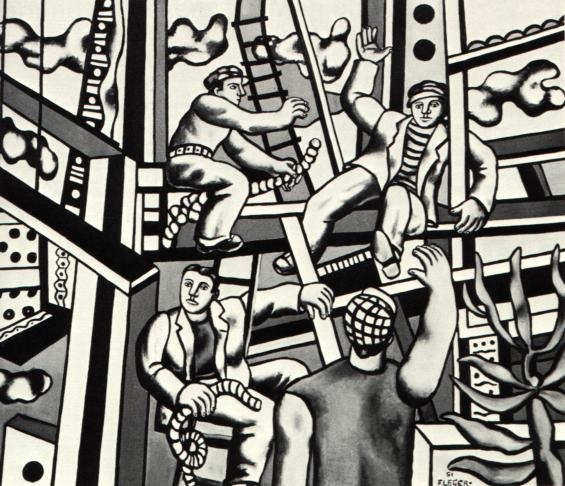

"Man and His World International Fine Arts Exhibition Expo 67 Montréal Canada" by Pierre Dupuy © the Canadian Corporation for the 1967 World Exhibition and the National Gallery of Canada
| Fernad Léger. 1881-1955
The Constructors with the Aloes. 1951 By 1950 when Léger executed the best-known versions of what he called "the experiment" of the Constructeurs group of paintings, he actually was returning to a concern that had occupied him early in his life: to find a way of integrating the human figure into the twentieth-century landscape of industrial forms. Both his early training as an architectural draughtsman and his pioneering Cubist works reflect this interest, since his early masterpieces Nudes in a Forest and Soldiers Playing Cards transform the human figure and its setting alike into the dehumanized and geometric forms of modern machinery. Immediately following the First World War, Léger's style evolved towards pure abstraction, suggesting, like the related Purist paintings of the great architect, Le Corbusier, the new possibilities of relating planed surfaces freely in space. Although biomorphically reintegrated human form was soon reintroduced into Léger's art under the impact of Surrealism, the numerous ambiguities of perspective and the sense of forms freely suspended and seemingly weightless in space found in the Constructeurs paintings retain the idea of a "made"' spatial system which the Dutch De Stijl and Russian Constructivist movements had introduced into western art by the early 1920s. Léger's optimistic acceptance of the mechanized society is accompanied by his egalitarian respect for the working class whom he represents as heroic, if undifferentiated, artificers of a joyous new world. Like Picasso, Léger has always shown considerable sympathy for radical socialist causes, and, unlike Picasso, he has managed to convey the highest, and perhaps most humanistically conceived goals of this social philosophy in his art. In this context, it should be recalled that the Constructeurs subject was executed by Léger not long after the Second World War, when admiration among artists and intellectuals for both the industrial achievements and the military resistance of socialism against Fascism was still running high. Significantly, Léger employed essentially the same repertory of forms and images to commemorate the themes of war and play that he used in the Constructeurs to treat the theme of human labour as the basis of industrial progress in equally general terms. Doubtless, Léger's wartime sojourn in the United States also contributed to the conception of the Constructeurs since the steel-frame structures appear more representative of New York City than of the immediate post-war European environment. It is even said that Léger's use of bright, unmixed, almost glowing colours was influenced from both Russia and the United States were united in the work of a major West European artist. Moreover, Léger's essentially classical restraint avoided the tendentious extremes of socialist realism and also the selective irony of contemporary pop art while somehow reaching out towards the highest aims of both styles. |